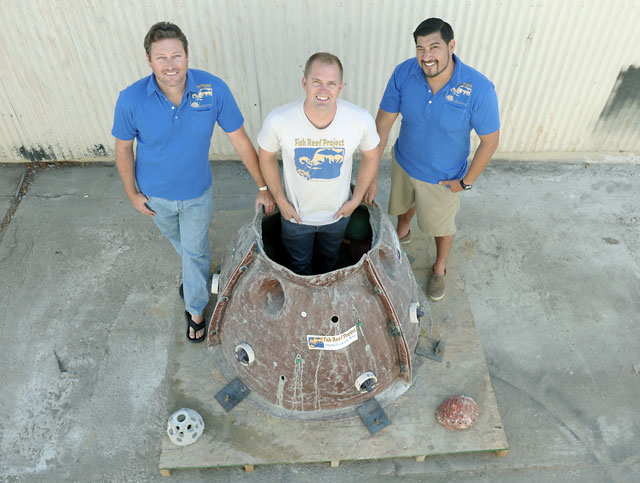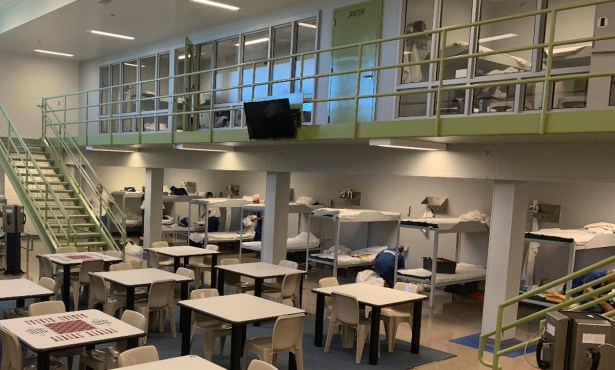Artificial Reef Project Moves Forward Despite Controversy
Two 1,300-Pound Reef Balls Were Dropped in the Ocean Off Hendry's Beach

Roughly five weeks ago, with the hope of jump-starting a plan to install a fish — and fishermen — friendly artificial reef offshore of Santa Barbara, Chris Goldblatt, himself a former commercial fisherman and outspoken critic of the recently imposed, state-sanctioned marine protected areas in Southern California, and some colleagues dropped two 1,300-pound hollow concrete igloos into the ocean offshore of Hendry’s Beach.
The custom-made objects, known as reef balls, were deployed with little fanfare and without the direct knowledge of any regulatory agency. As you can imagine, in a community that prides itself on keeping regular tabs on its ocean resources, that relative anonymity has been short-lived. “No doubt [Goldblatt] jumped the gun a bit,” explained the California Coastal Commission’s Cassidy Teufel last week. “At the very least, you definitely need a permit from us to do something like that.”
Premature ball-dropping aside, Goldblatt and his officially named Fish Reef Project are angling to eventually build a large artificial reef, roughly five acres in size, somewhere off the coast between Miramar Beach in Montecito and Loon Point in Summerland. The idea is that by creating a carefully designed hardscape habitat on the ocean floor comprising reef balls (3-by-4-foot rounded hollow shapes with various open portals on them and flat surfaces) and large quarry rocks, marine life will move in, new life will be recruited, and a thriving marine ecosystem will eventually develop in the area and form a space that proponents say will be a boon for both fishermen (recreational and commercial) and researchers alike. “If done right, there is just no downside to this,” opined Goldblatt recently. “Reefs are a rare and precious oasis of life, and we need more of them.”
The concept of an artificial reef is nothing new. In fact, not only did the California Department of Fish and Game have an actual reefing program for much of the second half of the 20th century (it was eventually defunded in 1989), but, as Goldblatt is quick to point out, there are artificial reefs currently off the shores of more than 70 countries, many of which use the reef ball technique. There are also success stories right here in California such as the SONGS (San Onofre Nuclear Generating Station) reef just south of San Clemente, built by Edison as a form of mitigation related to the nearby power plant.
However, despite this, the structures are not without controversy. After all, any time something large and manmade gets put in the ocean, there is always the chance for disaster. As Teufel — who, in his position as an Environmental Scientist for the Coastal Commission’s Ocean Resources Division, has had ample experience with similar projects — puts it, “It is not as simple as just chucking some materials down and getting kelp and fish populations to move in. There is quite a bit of scientific legwork required and a very lengthy permitting process that includes everyone from us to the State Lands Commission to the Army Corps of Engineers to Fish and Game.”
Other concerns held by groups such as the Environmental Defense Center and Santa Barbara Channelkeeper include the potential for an inappropriately sited artificial reef to cause a fish population sink or crash at nearby naturally occurring habitats or the luring of wildlife away from the safe haven of existing marine protected areas to unrestricted waters.
Given these worries, when word spread late last month that Goldblatt had already installed a pair of reef balls without really reaching out to the nearby environmental community or the various regulatory agencies, not only did the collective neckhairs of Santa Barbara’s various ocean watchdog groups stand straight up, but the Coastal Commission’s enforcement wing also opened up an official investigation and has since declared, via a written notice, that the two balls meet the definition of development under the Coastal Act and now must seek after-the-fact approval or be removed.
Adding to the controversy is the fact the balls were deployed as part of an existing aquaculture operation off of Hendry’s owned by Santa Barbara’s Justin Mezey. For his part, Goldblatt explained that the reef balls were technically plopped down, with Mezey’s permission, as anchors for Mezey’s Blue Revolution mussel and oyster aquaculture research business, the idea being that, by getting a few reef balls in local waters, he would be able to document how quickly they recruit life and thus provide some hard — albeit small sample size — evidence of what he hopes to accomplish in the future and boost fundraising efforts.
“It was a way to get a few of them down and see how they work,” said Goldblatt of the violating balls. “We weren’t trying to skirt any permitting; we just thought they were within the scope of the existing aquaculture permit.” Unfortunately, according to Coastal Commission staff, not only are the reef balls in need of permits, but Mezey’s entire operation — around since the mid 1990s under the jurisdiction of the City of Santa Barbara, thanks to the ribbon of Pacific Ocean given to the city to help with annexation of what is now the S.B. airport — also needs a permit from the Commission and, according to their enforcement staffers, has since been deemed to be in violation of the Coastal Act.
Despite the hiccups with the Commission staff, Goldblatt remains upbeat about the prospects for his plans. Saying he is actively working with the agency to get the proper approvals in place, Goldblatt detailed a “very positive” presentation he gave to the Advisory Council for the Channel Islands National Marine Sanctuary last week about the goals of the Fish Reef Project. “It is a form of peer review,” said Goldblatt about going before the Advisory Council. “Basically everyone from our ocean community is represented there. … Obviously, we have to address any concerns [they have] before we move forward.”
In the meantime, however, Goldblatt is most excited about the visit he paid last weekend to the illegal reef balls off Hendry’s. “Already they are just crawling with life,” he beamed. “There were starfish, small barnacles growing, crabs crawling around, and small rockfish swimming by. It was pretty cool to see.”



